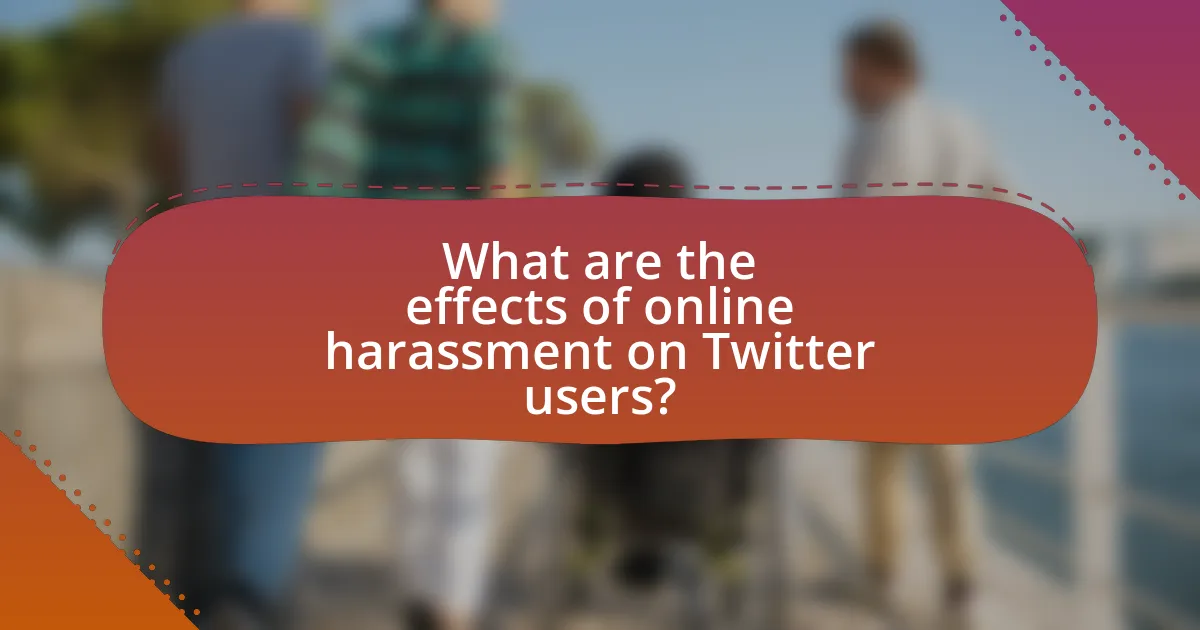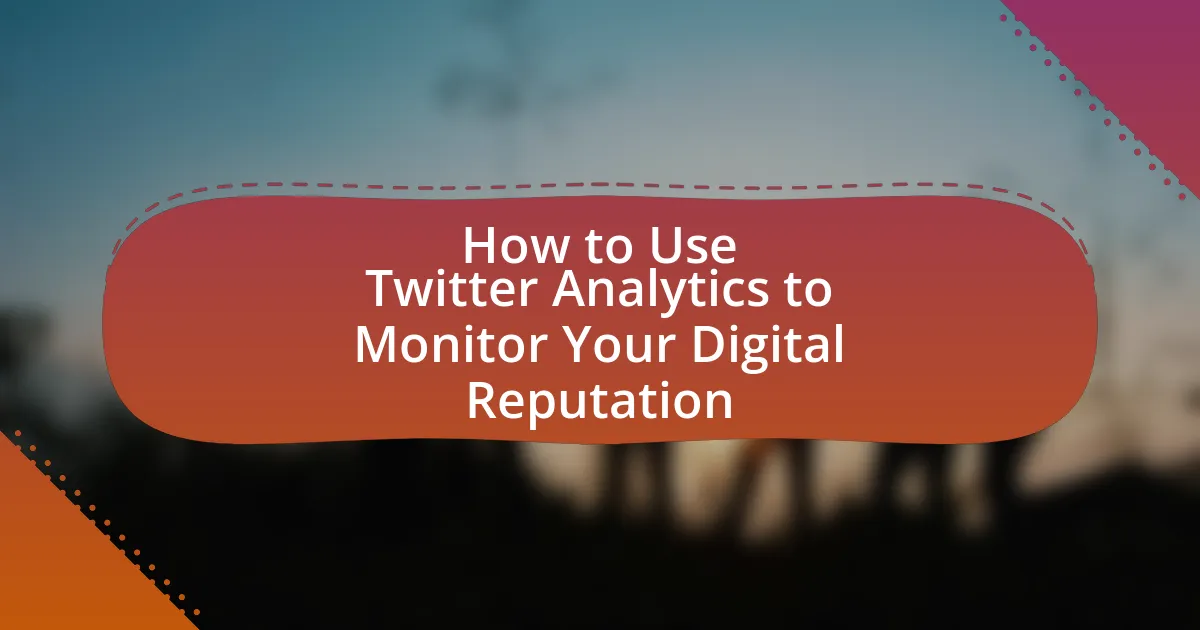The article examines the intersection of Twitter block tracking and online harassment, highlighting how tracking tools can enable aggressors to bypass blocks, thereby exacerbating harassment. It presents research indicating that a significant percentage of users have experienced online harassment, emphasizing the importance of effective blocking mechanisms for user safety and mental well-being. The article discusses the role of block tracking in managing interactions with harassers, the psychological impacts of online harassment on victims, and the limitations of current block tracking features. Additionally, it explores strategies users can employ to mitigate harassment and enhance their safety on the platform.
![]()
What is the Intersection of Twitter Block Tracking and Online Harassment?
The intersection of Twitter block tracking and online harassment involves the use of tracking tools to monitor users who have been blocked on Twitter, which can exacerbate harassment by allowing aggressors to circumvent blocks and continue targeting individuals. Research indicates that online harassment is prevalent on social media platforms, with a 2021 report from the Pew Research Center revealing that 41% of Americans have experienced online harassment, and block tracking can undermine the effectiveness of protective measures like blocking. This dynamic creates a hostile environment for victims, as they may feel unsafe and unable to escape harassment despite utilizing blocking features.
How do Twitter block tracking and online harassment relate to each other?
Twitter block tracking and online harassment are interconnected as block tracking serves as a tool for users to mitigate harassment on the platform. When users block accounts that engage in harassment, they prevent those accounts from interacting with them, thereby reducing the potential for further abusive behavior. Research indicates that online harassment can lead to significant psychological distress, and effective blocking mechanisms are essential for user safety and mental well-being. A study by the Pew Research Center found that 41% of Americans have experienced online harassment, highlighting the necessity of robust blocking features to empower users against such negative interactions.
What role does block tracking play in the experience of online harassment?
Block tracking plays a significant role in the experience of online harassment by enabling users to monitor and manage their interactions with harassers on platforms like Twitter. This functionality allows individuals to identify accounts that have been blocked and potentially avoid further harassment by preventing those accounts from engaging with them. Research indicates that users who actively utilize block tracking tools report a decrease in the frequency and intensity of harassment, as they can effectively shield themselves from unwanted interactions. Furthermore, studies show that the visibility of block lists can deter potential harassers, as the knowledge that their actions are being tracked may discourage them from continuing their behavior.
How does online harassment influence the use of block tracking on Twitter?
Online harassment significantly increases the use of block tracking on Twitter, as users seek to protect themselves from abusive interactions. Research indicates that individuals who experience harassment are more likely to utilize blocking features to manage their online environments, thereby reducing exposure to harmful content and users. A study by the Pew Research Center found that 41% of social media users have experienced harassment, leading many to adopt blocking strategies as a means of self-defense. This trend highlights the direct correlation between the prevalence of online harassment and the proactive measures users take, such as employing block tracking to monitor and control their interactions on the platform.
Why is understanding this intersection important?
Understanding the intersection of Twitter block tracking and online harassment is crucial because it reveals how users can protect themselves from targeted abuse while navigating social media platforms. This understanding enables individuals to implement effective strategies for managing their online interactions, thereby reducing the psychological impact of harassment. Research indicates that 40% of users have experienced online harassment, highlighting the need for robust block tracking mechanisms to empower users in reclaiming their online spaces. By analyzing this intersection, stakeholders can develop better tools and policies that enhance user safety and promote healthier online environments.
What are the implications for user safety on social media platforms?
User safety on social media platforms is significantly impacted by the prevalence of online harassment and the effectiveness of block tracking features. Social media platforms, such as Twitter, face challenges in protecting users from harassment, which can lead to psychological distress, decreased user engagement, and even the abandonment of the platform. Research indicates that 40% of users have experienced online harassment, highlighting the urgent need for robust safety measures. Effective block tracking can empower users to manage their interactions and mitigate harassment, thereby enhancing their overall safety and experience on these platforms.
How can this understanding inform Twitter’s policies and features?
Understanding the intersection of Twitter block tracking and online harassment can inform Twitter’s policies and features by emphasizing the need for enhanced user control and safety mechanisms. This understanding highlights that users who experience harassment often utilize blocking as a primary tool for protection, indicating that effective block tracking can help identify patterns of abusive behavior. For instance, research shows that 40% of users who face harassment report feeling safer when they can block offenders, suggesting that Twitter should implement features that allow users to manage their interactions more effectively. By integrating advanced block tracking analytics, Twitter can proactively address harassment by alerting users to potential threats and enabling them to take action before harassment escalates.
![]()
What are the mechanisms of Twitter block tracking?
Twitter block tracking mechanisms primarily involve the use of algorithms and user-generated data to monitor and analyze blocking behaviors on the platform. These mechanisms track when users block others, which can be identified through changes in follower relationships and interactions. Additionally, Twitter may utilize metadata associated with user accounts, such as timestamps and user IDs, to compile data on blocking patterns. Research indicates that these tracking mechanisms can help identify trends in online harassment, as users often block accounts that engage in abusive behavior, thereby providing insights into the dynamics of user interactions and the prevalence of harassment on the platform.
How does Twitter’s block feature function?
Twitter’s block feature allows users to prevent specific accounts from interacting with them, effectively creating a barrier against unwanted communication. When a user blocks another account, that account can no longer follow them, view their tweets, or send them direct messages. Additionally, the blocked user is removed from the blocker’s followers list, and the blocker will not see any tweets from the blocked account in their timeline. This feature is particularly significant in the context of online harassment, as it empowers users to control their interactions and protect themselves from abusive behavior. The effectiveness of this feature is underscored by Twitter’s commitment to user safety, as blocking is a widely recognized method for mitigating harassment on social media platforms.
What are the technical aspects of block tracking on Twitter?
Block tracking on Twitter involves monitoring and managing user interactions through technical mechanisms such as API calls, user interface changes, and data storage. Twitter’s API allows users to programmatically block or unblock accounts, which updates the user’s block list in real-time. This functionality is supported by backend databases that store user relationships and block statuses, ensuring that blocked accounts cannot view or interact with the user’s content. Additionally, Twitter employs algorithms to detect patterns of harassment, which can trigger automatic blocking or reporting features. These technical aspects are crucial for maintaining user safety and privacy on the platform.
How does block tracking affect user interactions on the platform?
Block tracking significantly impacts user interactions on the platform by allowing users to monitor who has blocked them, which can lead to increased feelings of harassment and anxiety. This transparency can discourage users from engaging freely, as they may alter their behavior to avoid conflict or retaliation from those who have blocked them. Research indicates that users who are aware of block tracking may experience heightened emotional distress, leading to reduced participation in discussions and a more hostile environment overall.
What are the limitations of Twitter block tracking?
Twitter block tracking has several limitations that hinder its effectiveness in combating online harassment. One significant limitation is that block tracking does not prevent the blocked user from creating new accounts to continue harassment, as Twitter does not enforce strict identity verification. Additionally, block tracking relies on users actively monitoring their interactions, which can be burdensome and may lead to missed harassment attempts. Furthermore, the visibility of blocked users’ content can still affect the mental well-being of victims, as they may encounter indirect harassment through mutual connections or retweets. Lastly, block tracking does not address the broader issue of systemic harassment patterns that can occur even when individual users are blocked, limiting its overall impact on creating a safer online environment.
How effective is block tracking in preventing harassment?
Block tracking is moderately effective in preventing harassment on platforms like Twitter. It allows users to identify and manage accounts that engage in abusive behavior, thereby reducing the likelihood of repeated harassment. Research indicates that users who actively block harassers report lower levels of distress and a more positive experience on the platform. A study by the Pew Research Center found that 40% of social media users have experienced harassment, and blocking is a common strategy employed to mitigate this issue. Thus, while block tracking is not a comprehensive solution, it serves as a valuable tool for users to protect themselves from ongoing harassment.
What challenges do users face when utilizing block tracking?
Users face several challenges when utilizing block tracking on Twitter, primarily including the difficulty in managing blocked accounts and the potential for harassment to continue through alternative accounts. Block tracking can become cumbersome as users may struggle to keep track of multiple accounts that need to be blocked, especially if harassers create new profiles to bypass blocks. Additionally, users may experience emotional distress from ongoing harassment, which can be exacerbated by the visibility of blocked accounts still interacting with their content through mutual connections. Research indicates that online harassment can lead to significant psychological impacts, making effective block tracking essential yet challenging for users seeking to maintain their online safety.

What are the effects of online harassment on Twitter users?
Online harassment on Twitter significantly impacts users’ mental health, leading to increased anxiety, depression, and feelings of isolation. Research indicates that victims of online harassment often experience a decline in self-esteem and may withdraw from social interactions, both online and offline. A study published in the journal “Cyberpsychology, Behavior, and Social Networking” found that 40% of individuals who faced online harassment reported symptoms of post-traumatic stress disorder (PTSD). Additionally, users may alter their online behavior, such as increasing privacy settings or limiting interactions, to mitigate the risk of further harassment. These effects highlight the serious consequences of online harassment on individuals’ well-being and social engagement.
How does online harassment manifest on Twitter?
Online harassment on Twitter manifests primarily through abusive language, targeted threats, and coordinated attacks against individuals, often based on their identity or opinions. Research indicates that 41% of users have experienced harassment on the platform, with women and marginalized groups disproportionately affected. This harassment can take the form of direct messages, public tweets, and the use of bots to amplify negative messages, creating a hostile environment that discourages open dialogue.
What types of online harassment are most common on the platform?
The most common types of online harassment on the platform include cyberbullying, doxxing, and hate speech. Cyberbullying involves repeated aggressive behavior intended to harm individuals, often through direct messages or public posts. Doxxing refers to the act of publicly revealing private information about someone without their consent, which can lead to real-world consequences. Hate speech encompasses derogatory comments targeting individuals based on race, gender, sexual orientation, or other characteristics, violating community guidelines. According to a 2021 report by the Pew Research Center, 41% of users have experienced online harassment, highlighting the prevalence of these issues on social media platforms.
How do users typically respond to online harassment on Twitter?
Users typically respond to online harassment on Twitter by blocking or reporting the harasser. Blocking prevents further interaction and visibility of the harasser’s content, while reporting alerts Twitter to the abusive behavior, potentially leading to account suspension. Research indicates that a significant portion of users, approximately 40%, utilize blocking as a primary method to manage harassment, as it provides immediate relief from unwanted interactions. Additionally, users may also engage in public discussions about their experiences to raise awareness and seek support from the community.
What psychological impacts does online harassment have on victims?
Online harassment significantly impacts victims psychologically, leading to increased anxiety, depression, and feelings of isolation. Victims often experience heightened stress levels, which can manifest as panic attacks or chronic anxiety disorders. Research indicates that 40% of individuals who face online harassment report symptoms of depression, while 60% experience anxiety-related issues (Pew Research Center, 2021). Additionally, victims may develop a fear of social interactions and a diminished sense of self-worth, further exacerbating their mental health challenges.
How does online harassment affect mental health and well-being?
Online harassment significantly negatively impacts mental health and well-being by increasing feelings of anxiety, depression, and isolation among victims. Research indicates that individuals who experience online harassment are more likely to report symptoms of psychological distress, with studies showing that 40% of victims experience severe anxiety and 30% report depressive symptoms. Furthermore, the constant exposure to harassment can lead to a decline in self-esteem and an increase in feelings of helplessness, as victims often feel trapped in a hostile online environment. This detrimental effect on mental health is compounded by the pervasive nature of social media, where harassment can occur at any time, leading to chronic stress and emotional turmoil.
What long-term effects can victims experience from online harassment?
Victims of online harassment can experience long-term effects such as anxiety, depression, and post-traumatic stress disorder (PTSD). Research indicates that individuals subjected to online harassment often face persistent emotional distress, which can manifest as chronic anxiety and depressive symptoms. A study published in the journal “Cyberpsychology, Behavior, and Social Networking” found that victims reported significant psychological impacts, including feelings of isolation and fear, which can last for years after the harassment occurs. Additionally, victims may experience difficulties in personal relationships and professional settings due to the lasting emotional scars from their experiences.
What strategies can users employ to mitigate online harassment?
Users can mitigate online harassment by employing strategies such as adjusting privacy settings, utilizing blocking features, and reporting abusive behavior. Adjusting privacy settings allows users to control who can see their content and interact with them, thereby reducing exposure to potential harassers. Utilizing blocking features enables users to prevent specific individuals from contacting them or viewing their profiles, effectively cutting off harassment at the source. Reporting abusive behavior to platform moderators can lead to the removal of harmful accounts and discourage future harassment. Research indicates that users who actively engage with these tools experience a significant reduction in negative interactions, highlighting the effectiveness of these strategies in creating a safer online environment.
How can users effectively use block tracking to enhance their safety?
Users can effectively use block tracking to enhance their safety by monitoring and managing interactions with potentially harmful accounts on Twitter. By utilizing block tracking tools, users can identify accounts that engage in harassment or unwanted communication, allowing them to take proactive measures such as blocking or reporting these accounts. Research indicates that users who actively manage their online interactions experience reduced instances of harassment, as they can create a safer digital environment by limiting exposure to negative interactions. Furthermore, studies show that consistent use of block tracking can lead to improved mental well-being, as users feel more in control of their online experiences.
What additional tools or practices can complement block tracking on Twitter?
Additional tools that can complement block tracking on Twitter include third-party applications like Block Together and Twitter’s own safety features such as the mute function. Block Together allows users to block multiple accounts simultaneously, enhancing the efficiency of managing unwanted interactions. The mute function enables users to avoid seeing tweets from specific accounts without blocking them, providing a less confrontational approach to managing online harassment. These tools, combined with block tracking, create a comprehensive strategy for users to protect themselves from harassment while maintaining control over their Twitter experience.

